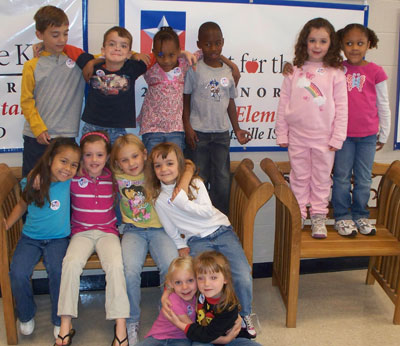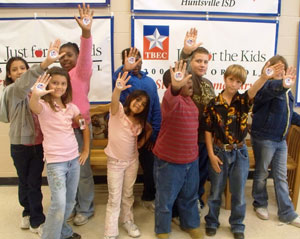Local Students Exercise Right In Voting Lesson
 |
| Children from Huntsville's Stewart Elementary show off their "I Voted" stickers after casting their ballots in the Political Science Junior Fellows mock election last week. Fifty-six percent of all students voted for Obama. |
While 61 percent of Walker County voted for Sen. John McCain in last night’s presidential election, students at several Huntsville schools had a different take on the candidates.
Through a mock election, sponsored last week by Sam Houston State’s Political Science Junior Fellows, the majority of students at Huntsville’s Gibbs, Stewart and Samuel Houston elementary schools, as well as Mance Park Middle School, voted for President-elect Barack Obama.
A total of 56 percent voted for Obama, with McCain earning almost 44 percent of the vote. Of the four schools polled, only Stewart Elementary’s vote made McCain the winner, 52 percent to 47.5 percent, when broken down by school. Obama won the other three schools by earning almost 60 percent of the vote.
“We all thought the mock voting exercise was successful,” said Mike Yawn, visiting professor of political science and junior fellows adviser. “More than 1,500 students ‘voted,’ and almost all of them showed real enthusiasm for the process.
“A significant number of the students expressed interest in the process, asking questions and initiating conversations afterward,” he said. “We were also impressed by the teachers. Many of them incorporated the exercise into the curriculum, a fact reflected by the students' knowledge of issues and the candidates.”
The project was designed to create a “positive learning experience” for school-aged children about the voting process, according to junior fellow Laken Jenkins.
“We think of voting as gateway engagement, a low-investment act of involvement,” said junior fellows president Megan Bryant. “We know that people who vote are also more likely to be engaged in their community—volunteering, serving on boards, and generally organizing to make their community and country a better place. We hope that the mock-voting exercise plants that seed.”
In order to make the mock election as realistic as possible, students were required to sign in and show identification before being allowed to vote, and no campaign literature, buttons or signs were allowed near the voting site.
Ballots were distributed, collected and tallied by the Huntsville YMCA, working in conjunction with the fellows in the event.
 “For the youngest of the school children (4 and 5 year olds), we changed the process a bit,” Yawn said. “We offered the students a strip of paper, and they could cast this ballot (privately) into one of two ballot boxes designated ‘McCain’ or ‘Obama.’
“For the youngest of the school children (4 and 5 year olds), we changed the process a bit,” Yawn said. “We offered the students a strip of paper, and they could cast this ballot (privately) into one of two ballot boxes designated ‘McCain’ or ‘Obama.’
“The boxes were labeled, but since most four and five year olds cannot read, a picture was included on each box,” he said.
Yawn said the students involved in the voting process also seemed to learn a lot.
“Most of the students knew something about the candidates,” he said. “One elementary student who voted for McCain, for example, felt compelled to write on the ballot ‘Obama's not taking my gun away!’ Another student, this time an Obama voter, wrote ‘I good, we need change!’ Others, even 4 and 5 year olds, were aware of the candidates for whom their parents were voting.
“It helped significantly that so many teachers incorporated learning activities into the curriculum,” he said. “In this manner, students were able to have some level information going into the ‘voting sites,’ and then learning more about the process of voting at the mock election.”
On Tuesday morning, as votes were being cast nation wide, Yawn predicted that the actual election results would be similar to the results of the four schools’ vote, adding that “it’s not entirely clear why Obama did better at most of the schools, especially since it is unlikely that Obama will win Walker County among adults.
“Obama's more youthful appearance, the distinctiveness of his name, and the significant number of African-American students at the schools probably played a role,” he said. “There was also a strong group dynamic at play.
“Based on overhearing conversations, it appeared that if a class had two or three students who were enthusiastic about a particular candidate, then the entire class rallied behind that candidate.”
- END -
SHSU Media Contacts: Jennifer Gauntt
Nov. 5, 2008
Please send comments, corrections, news tips to Today@Sam.edu
This page maintained by SHSU's Communications Office
Director: Bruce Erickson
Assistant Director: Julia May
Writer: Jennifer Gauntt
Located in the 115 Administration Building
Telephone: 936.294.1836; Fax: 936.294.1834
Please send comments, corrections, news tips to Today@Sam.edu.
- Undergrads Present Research
- Del Carmen Wins National Award
- Prof Chews On Geophagy Research
- April Recognized As Awareness Month
- CJ Honors Its Outstanding
- Center Hosts Awareness Activities
- President's Retirement Event Held
- Hooten Named Men's Basketball Coach
- Ring Ceremony Breaks Record
- Trip Takes Summer Classes West
- SHSU Receives First Patent Royalties
- 'Bone Lady' Gives 'Faculty' Lecture
- Seminar Gives Health Care Facts
- Research Clinic Benefits Children
- University Opens Regional Crime Lab
- Distinguished Educators Named
- Grad First Woman To Get Bar Award
- Week Prepares Students For Break
- Documentarian Gives Lectures
- Regents Approve Center Renovation
- Faculty, Staff Giving Breaks Records
- Events Celebrate Namesake, Texas
- Center Holds Financial Literacy Week
- SHSU Sends System To Afghanistan
- New Technology Aids In Fighting Crime
- Students Sought For Rural Internships
- SHSU Receives Incentive Check
- Musicians To Participate In Exchange
- Doctoral Program Earns Accreditation
- Class Recycles Sustainability Idea
- Week Prepares Students For V-Day
- SHSU Web Site Gets Redesign
- Fritz Named Head Football Coach
- Funds Donated For Center Renovation
- Center Establishes Mentorship Award
- Blatchley, Bamberg Are Grad Speakers
- H1N1 Vaccine Available For Students
- Regents Approve Tuition, Fee Increases
- Fifth Graders Get Science Lessons
- STAFS Provides Solutions In First Year
- Students Make Peanut Butter For Project
- Mentoring Program Helps CS Students
- Dean Offers Eating Tips For Students
- Four Named To COBA Hall Of Honor
- Water Treatment Technology Produced
- Rivalry Game Moving To Houston
SHSU 'In the News'
Brian Domitrovic, assistant professor of history, appeared on Book TV (C-SPAN) May 1-2, speaking about his recent book "Econoclasts: The Rebels Sparked the Supply Side Revolution and Restored American Prosperity" (www.econoclasts.net).
Houston Chronicle education writer Jeannie Kever recently turned to Regents Professor of English Paul Ruffin for his views on university presses moving toward "digital books" as opposed to traditional ink-on-paper."We're fulfilling the ancient role of the university press, and that is to produce books," said Paul Ruffin, the Texas poet laureate for 2009 and director of the Texas Review Press at Sam Houston State University. "I don't want to give up the book because it is an art."
Faculty/Staff Birthdays
Monday, May 3
Tuesday, May 4
Staff Council Spotlights
